A Buzzy Art Scene Has Popped Up in the Cayman Islands — Here's What to See
The Cayman Islands are known more for banking than the visual arts. But the destination has an abundance of exciting galleries and museums to explore.
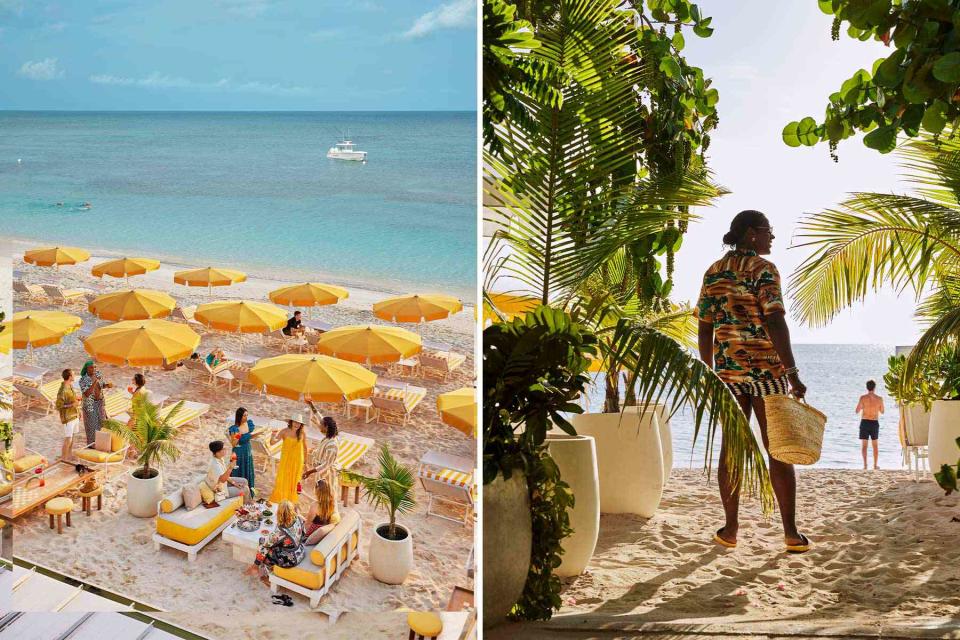
Alpha Smoot
From left: Guests mingle at the Palm Heights hotel, on Grand Cayman; the beach at Palm Heights.The sand on Grand Cayman’s Seven Mile Beach was every bit as soft and white as I remembered, the water just as mesmerizingly turquoise. But on this trip, there were no cruise ships bobbing on the horizon like oversize tub toys. No reggae blared from unseen speakers. No day-trippers swarmed the beach with their matching striped towels and logo-adorned beach bags. The usual bustle was reduced to an occasional walker, and I couldn’t tell whether they were locals or tourists. From the shade of my canopied chaise, I surveyed the sunny scallop of sand and counted a total of nine people.
I had missed this strip of coastline. Grand Cayman’s marquee beach, technically a little less than six miles long (but who’s counting?), has always been a favorite spot of mine. I’ve downed frosty bottles of Caybrew at its many beach bars; shopped at its hotel boutiques; and, of course, sunk my toes into its sugar-fine sand more times than I can count. But after the Cayman Islands, like the rest of the Caribbean, locked down in March 2020, the country didn’t reopen the following summer or fall, as many of its neighbors did. Instead, the self-governing British overseas territory stayed largely off-limits to vacationers for almost two years. In the process, it successfully protected the population of just over 67,000 from the ravages of the pandemic.
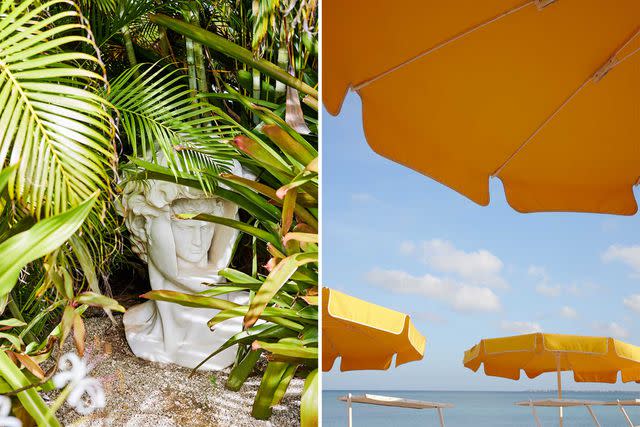
Alpha Smoot
From left: The sculpture garden at the National Gallery of the Cayman Islands features Spirit Within, by David Junquist; beach umbrellas at Palm Heights hotel.“We did miss the tourists. They’re an important part of our economy,” said Hannah Ebanks, the public relations officer from the Department of Tourism, on the first day of my visit. We were eating fancy grilled cheese sandwiches, scented with truffle, at the Brasserie, in the heart of George Town, the capital. “But, as a local, it was really nice to enjoy Seven Mile Beach and have that little slice of heaven all to ourselves.”
There are more than 100 nationalities represented on the Cayman islands, and expats make up 46 percent of Grand Cayman’s roughly 65,000 residents.
Last November, tourists were allowed back, but under strict entry regulations. My eight-day stay in January required proof of vaccination and two pre-arrival COVID tests, plus three more during my time on the island. (All vaccinated Americans are now allowed entry without testing.) But as I watched the territory’s trio of emerald islands come into view below me from my window seat on a Cayman Airways flight, I had a feeling the hassle would be worth it.
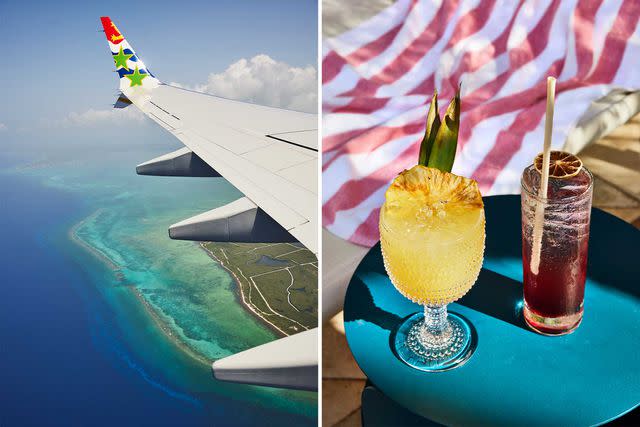
Alpha Smoot
From left: Flying in to Grand Cayman; cocktails at Ms. Piper’s Kitchen & Garden restaurant.In many ways the Cayman Islands are a Caribbean anomaly. The nation is the wealthiest in the region, and there are no direct taxes on income, sales, or property. And it is banking and financial services — not tourism — that drives the economy. This wealth meant that, unlike many in the Caribbean, the destination could afford to shut out the cruise ships for as long as it deemed necessary, relinquishing millions of dollars in passenger revenue in the process. (Grand Cayman finally reopened to cruises in March.)
There are more than 100 nationalities represented on the islands, and expats — mostly from Jamaica, the Philippines, the U.K., India, and Canada — make up 46% of Grand Cayman’s roughly 65,000 residents. The territory’s other islands, Cayman Brac and Little Cayman, have a population of about 2,300 combined.
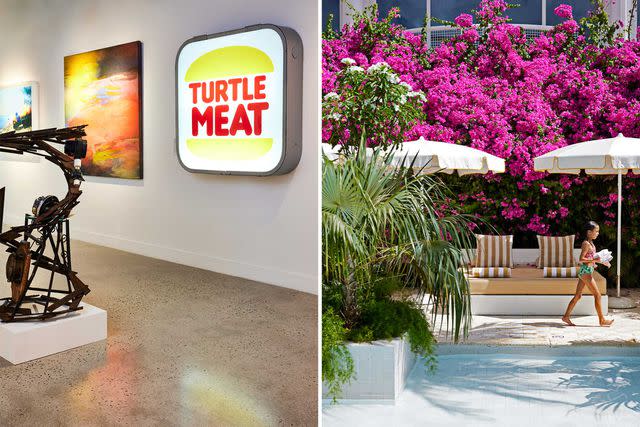
Alpha Smoot
From left: Our Way 1994-1999, by Caymanian artist Wray Banker, hangs in the National Gallery of the Cayman Islands; a bougainvillea-fringed swimming pool at Palm Heights.But, in contrast to Jamaica, where I lived for many years, I’ve always found Caymanian culture hard to define. (The islands never had an Indigenous population, and the first settlers, in the 16th century, included pirates and shipwrecked sailors.) On my Cayman Airways flight, the recorded messages were delivered in a distinctly British accent. At the international airport — a sleek and gleaming hub since a major renovation that was completed in February 2021 — I recognized the lilt of a Jamaican voice over the PA system. And I heard so many American and Canadian twangs among residents greeting their guests at Arrivals, it was hard to know who was who.
Related: 15 Mistakes to Avoid on Your Caribbean Vacation
So on this trip, my goal was to dig a bit deeper into Caymanian culture, to discover the aspects of Grand Cayman I’ve overlooked in my eagerness for beachy fun in the sun. Even from my prime position on the sand, I didn’t have to go far to find it.
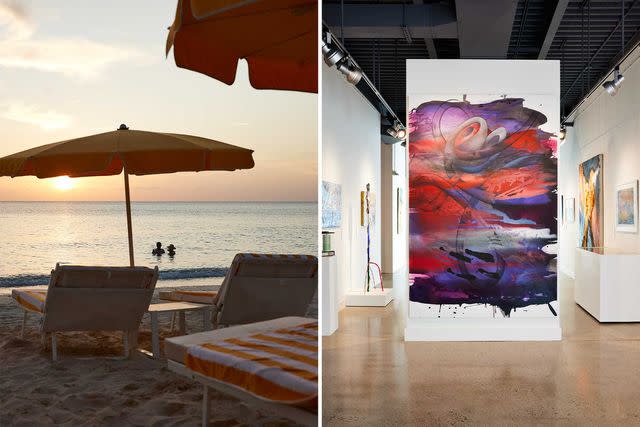
Alpha Smoot
From left: A sunset swim off Seven Mile Beach; Personage Transformed, by Bendel Hydes, in the National Gallery of the Cayman Islands.Straddling both sides of the main road that runs along Seven Mile Beach, the Ritz-Carlton, Grand Cayman is the largest resort in the Cayman Islands. It’s a 16-year-old fixture that’s famous for the fine-dining seafood restaurant Blue by Eric Ripert and the Cayman Cookout a weekend food festival sponsored by T+L’s sister publication, Food & Wine, to which Ripert invites fellow chefs from around the world. Evidence of last year’s $50 million renovation — designed to celebrate the territory’s history and geography — is everywhere. A motif of the national tree, the silver thatch palm, repeats in the carpeting; the glass chandelier in the lobby echoes the form of Cayman’s coral reefs; the oversize baskets suspended from the ceiling in the Silver Palm Lounge show off Caymanian straw-weaving traditions. And wooden chairs trimmed with hand-plaited silver thatch leaves are a nod to the country’s past as an exporter of rope.
Related: An Art Lover's Guide to the Bahamas
This attention to the Cayman vernacular is a welcome departure from the somewhat stuffy, could-be-anywhere design the hotel used to have. But I was struck most by the art — all of it by Caymanians — that was brought in during the upgrade. Scaling the wall above a stairway off the lobby is John Bird’s "Coconuts," an installation made of ebonized wood reclaimed from the airport renovation. Nearby, on a covered bridge that connects the wings of the resort, is the Cayman Islands’ largest art gallery (officially, “The Art Gallery at the Ritz-Carlton”). The space showcases the work of more than 40 local artists, divided by medium (photography, painting, mixed-media collage) and theme (abstract, portrait, and landscape). Curated by Cayman-born artist Chris Christian, it’s a revolving collection that is modified as pieces are sold.
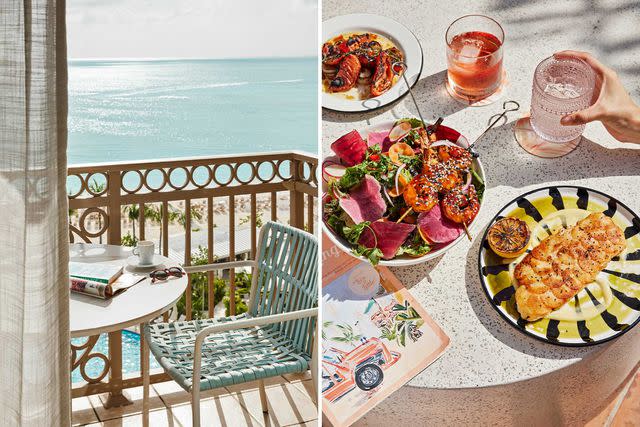
Alpha Smoot
From left: A guest room at the Ritz-Carlton, Grand Cayman, which overlooks Seven Mile Beach; grilled vegetables, shrimp skewers, and branzino with potato “scales” at Ms. Piper’s.The best place to discover Caymanian art and to understand its evolution, however, is a five-minute drive away at the National Gallery of the Cayman Islands, a pair of sleek two-story buildings surrounding a series of gardens, including one dedicated to sculpture. Visitors can also access the gallery from Seven Mile Beach, via a new pedestrian underpass to the shopping, entertainment, and dining hub Camana Bay. When I visited, “Saltwater in Their Veins” was the featured exhibition, which examined the centuries-old relationship Caymanians have with the sea. It featured works by 75 contemporary artists who have made the island their home.
Aside from those tropical pleasures that we all dream about during the frigid winter months, there is so much more to explore.
Inside the museum, which was founded in 1996, are several beautiful woven straw baskets and bags, created from local palm fronds using the same skills that rope makers employed for more than a century, until the tradition died out in the 1960s. Other works, like those of the self-taught Gladwyn K. “Miss Lassie” Bush, who at 62 started painting on the walls, windows, and furniture of her home in George Town, are representative of the artistic milieu in the 70s.
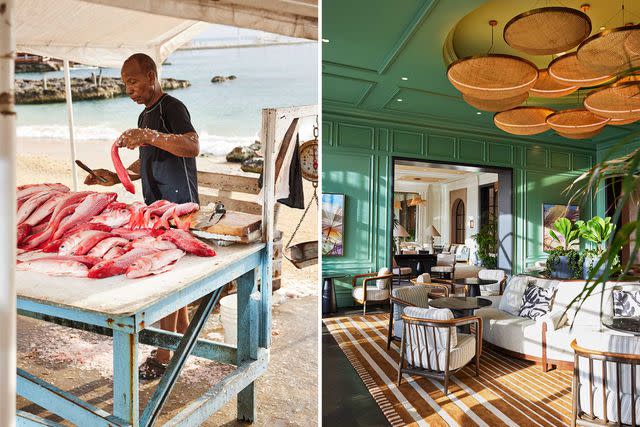
Alpha Smoot
From left: A fishmonger sells red snapper at a beachside market in George Town; the Silver Palm lounge at the newly renovated Ritz- Carlton, Grand Cayman.By the 80s, as more Caymanians sought formal training or studied abroad, the focus shifted again: works from this period addressed issues such as immigration, ethnicity, and, in the case of Davin Ebanks’s "Death of Ajax" — which incorporates five turtle skulls and the blueprints of a catboat, the vessel traditionally used to hunt turtles — the urban development and global influences that are threatening traditional Caymanian ways of life. Meanwhile, Wray Banker’s piece "Our Way 1994–1999" subverts a fast-food logo, replacing a famous brand name with “turtle meat” as a commentary on the homogenization of Caribbean culture.
I thought more about the work over lunch nearby, at Ms. Piper’s Kitchen & Garden. This restaurant opened on the Seven Mile strip in summer 2021, behind what was formerly the Comfort Suites and is now the retro-cool Hampton by Hilton Grand Cayman Seven Mile Beach. It’s a cheerful, blush-hued indoor/outdoor poolside spot, conceptualized as the home of the fictional Ms. Piper, an adventurer who arrived on the island from Nairobi, Kenya, in the 70s. I was impressed with the attention to details such as matching staff uniforms to the pink umbrellas around the pool, the eclectic wicker furniture, and the menu, presented as a magazine complete with a vintage Cayman Airways ad on the back.
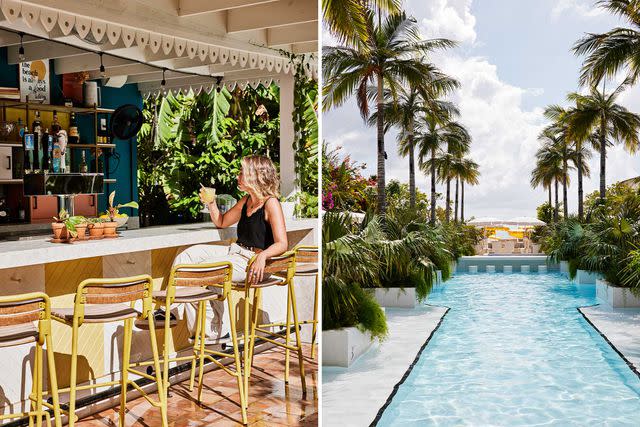
Alpha Smoot
From left: The bar at Ms. Piper’s; one of two swimming pools at Palm Heights, looking toward Seven Mile Beach.Although I had never stayed at Palm Heights, the moment I glimpsed its beach umbrellas sprouting from the sand like giant buttercups, it felt like home (their color, sunshine yellow, happens to be my favorite). The 50-suite hotel, formerly the Beach Suites, opened in October 2019. It’s a haven for creative types — and those who want to be near them — who crave a bit of visual stimulation with their relaxing resort vibes. Palm Heights’ commitment to the arts is clear: it hosts an ongoing residency program for painters, sculptors, musicians, writers, and chefs, who come to stay and work at the property for one, two, or three months. Recent participants have included dancer and choreographer Gabe Stone Shayer (a soloist at the American Ballet Theatre in New York), the multidisciplinary artist Kenturah Davis (who splits her time between Los Angeles and Accra, Ghana), and Dina Nur Satti, a Brooklyn-based ceramic artist.
More Trip Ideas: The 25 Best Resort Hotels in the Caribbean, Bermuda, and the Bahamas
Palm Heights is creative director and founder Gabriella Khalil’s first foray into the hospitality business. The entrepreneur, who spends part of her time in London and New York, fell in love with the island a decade ago. Her goal, she told me, was to build a design-forward hotel where innovative people — Caymanians and visitors alike — could work and play. “We wanted to take a different approach to a Caribbean hotel,” she said, “both in terms of how it looks and the guest experience. To bring back that Slim Aarons, jet-set era of the Caribbean. But also to incorporate the work of today’s artists, locally and from around the world.”
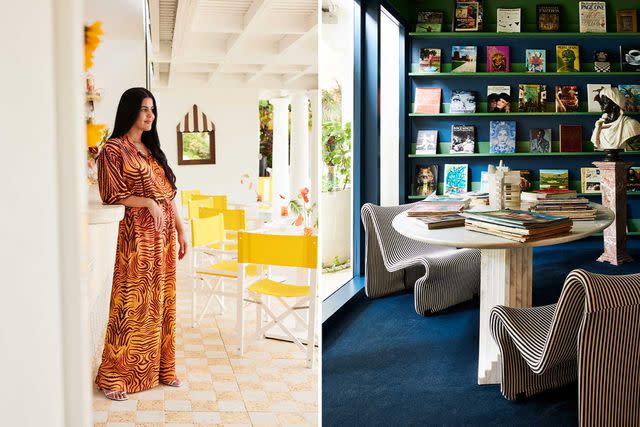
Alpha Smoot
From left: Gabriella Khalil, founder and creative director of Palm Heights, in the hotel’s Coconut Club; photography and art books in the library at Palm Heights.Khalil’s vision is evident throughout the property. In the palm-tree-lined restaurant, Tillies, the walls are clad in white latticework, from which hang an assortment of straw baskets and paintings by artists from the island and abroad. Khalil created the interiors in collaboration with New York designer Sarita Posada and Los Angeles designer Courtney Applebaum, and several of the airy suites showcase bold, abstract portraits commissioned from Caymanian artist John Reno Jackson. Just off the breezeway at the hotel’s entrance, a painting by Nigerian artist Tega Akpokona (who completed a residency last spring) depicts an island woman in a dazzling scarlet dress.
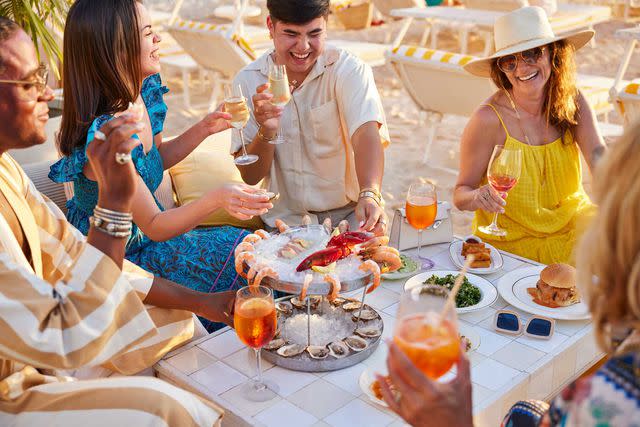
Alpha Smoot
Cocktail hour at Palm Heights.On my last evening, I walked along a quiet stretch of Seven Mile Beach as the sunlight faded. Now that we have put the worst of the pandemic behind us, I thought, visitors will soon be making a beeline for the very spot I had all to myself. But aside from those tropical pleasures that we all dream about during the frigid winter months, there is so much more to explore. The island’s artistic and creative scene might not be well known to the world. It’s a hidden treasure that offered me an entirely new way to see a place I thought I knew well. Yes, the beaches are worth the trip. But so, too, is the thrill of discovery.
A version of this story first appeared in the November 2022 issue of Travel + Leisure under the headline Treasure Island.
For more Travel & Leisure news, make sure to sign up for our newsletter!
Read the original article on Travel & Leisure.

